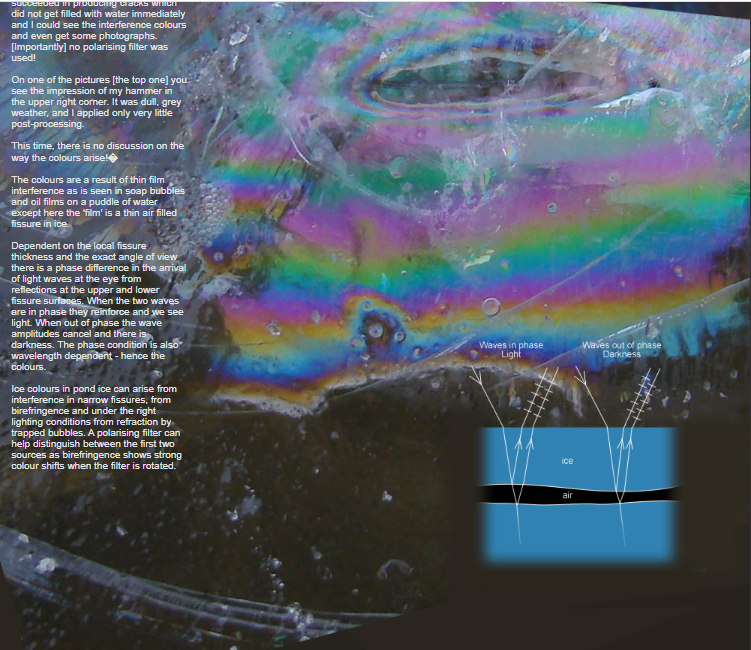Breaking the Ice
Breaking the Ice: Unveiling the Colorful Secrets of Pond Ice
When it comes to the mesmerizing colors found in pond ice, there has been a lively debate among enthusiasts and scientists alike. The question at hand is whether these colors are a result of the ice's birefringence or the interference of light across thin fissures, or perhaps a combination of both. To settle this matter, Dieter Zawischa, in collaboration with another researcher, decided to take matters into their own hands and conduct an experiment.
Rather than relying on mere opinions, Dieter armed himself with a hammer and headed to a nearby icy pond. Inspired by the work of Eva Seidenfaden, he aimed to replicate her findings on induced fissures in ice. Despite the relatively thin and uneven ice surface, Dieter successfully produced cracks that did not immediately fill with water, allowing him to witness the mesmerizing interference colors and capture them in photographs. Importantly, he achieved these results without using a polarizing filter.
In one of the photographs, we can even see the impression left by Dieter's hammer in the upper right corner. The weather that day was dull and grey, and the images underwent minimal post-processing. This time, there was no room for discussion regarding the origin of the colors observed.
The captivating colors seen in pond ice are a consequence of thin film interference, similar to what occurs in soap bubbles or oil films on water puddles. However, in this case, the "film" responsible for the colors is a narrow air-filled fissure within the ice.
The colors arise due to a phase difference in the arrival of light waves at the observer's eye from reflections at the upper and lower surfaces of the fissure. When these waves are in phase, they reinforce each other, resulting in visible light. Conversely, when they are out of phase, the wave amplitudes cancel each other out, creating darkness. Additionally, the phase condition is influenced by the wavelength of light, leading to the emergence of different colors.
Interestingly, the colors observed in pond ice can stem from various sources, including interference in narrow fissures, birefringence, and, under specific lighting conditions, refraction by trapped bubbles. To distinguish between interference and birefringence as the primary source of color, a polarizing filter can be utilized. Birefringence exhibits pronounced color shifts when the filter is rotated, aiding in the identification of its contribution to the overall coloration.
In conclusion, the stunning colors witnessed in pond ice are a result of intricate optical phenomena. By exploring the interaction of light with thin air-filled fissures within the ice, we can unravel the secrets behind these captivating displays. Whether it's the interference of light waves or the birefringence of ice crystals, each factor plays a role in creating the vibrant hues that grace our frozen landscapes. Through experimentation and observation, we continue to deepen our understanding of the intricate workings of nature's artistic palette.

Breaking the Ice ~ Dieter Zawischa hit pond ice with a hammer to produce these colours. ©Dieter Zawischa, shown with permission.
Dieter and I have been having a friendly discussion on the origin of colours in pond ice. Are they from the birefringence of the ice itself or from interference of light across thin fissures? Or both?
Science is about experiment rather than opinion and so Dieter attacked a nearby icy pond. �Instead of a polarising filter, yesterday I took a hammer with me when I looked for the ice on a nearby pond. What I did was not very inventive - knowing Eva Seidenfaden's site I just wanted to reproduce her results (1,2,3) on induced fissures in ice.
The ice was not very thick and not really smooth, but nevertheless I succeeded in producing cracks which did not get filled with water immediately and I could see the interference colours and even get some photographs. .Importantly. no polarising filter was used!
On one of the pictures .the top one. you see the impression of my hammer in the upper right corner. It was dull, grey weather, and I applied only very little post-processing.
This time, there is no discussion on the way the colours arise!�
The colours are a result of thin film interference as is seen in soap bubbles and oil films on a puddle of water except here the 'film' is a thin air filled fissure in ice.
Dependent on the local fissure thickness and the exact angle of view there is a phase difference in the arrival of light waves at the eye from reflections at the upper and lower fissure surfaces. When the two waves are in phase they reinforce and we see light. When out of phase the wave amplitudes cancel and there is darkness. The phase condition is also wavelength dependent - hence the colours.
Ice colours in pond ice can arise from interference in narrow fissures, from birefringence and under the right lighting conditions from refraction by trapped bubbles. A polarising filter can help distinguish between the first two sources as birefringence shows strong colour shifts when the filter is rotated.

Note: this article has been automatically converted from the old site and may not appear as intended. You can find the original article here.
Reference Atmospheric Optics
If you use any of the definitions, information, or data presented on Atmospheric Optics, please copy the link or reference below to properly credit us as the reference source. Thank you!
-
<a href="https://atoptics.co.uk/blog/breaking-the-ice/">Breaking the Ice</a>
-
"Breaking the Ice". Atmospheric Optics. Accessed on November 26, 2024. https://atoptics.co.uk/blog/breaking-the-ice/.
-
"Breaking the Ice". Atmospheric Optics, https://atoptics.co.uk/blog/breaking-the-ice/. Accessed 26 November, 2024
-
Breaking the Ice. Atmospheric Optics. Retrieved from https://atoptics.co.uk/blog/breaking-the-ice/.